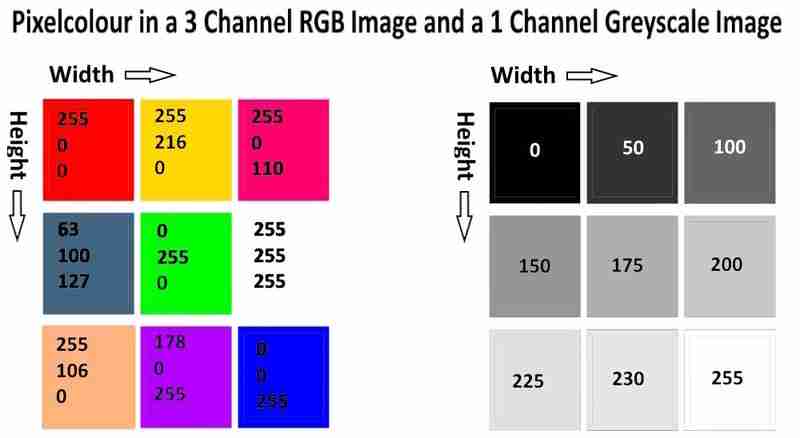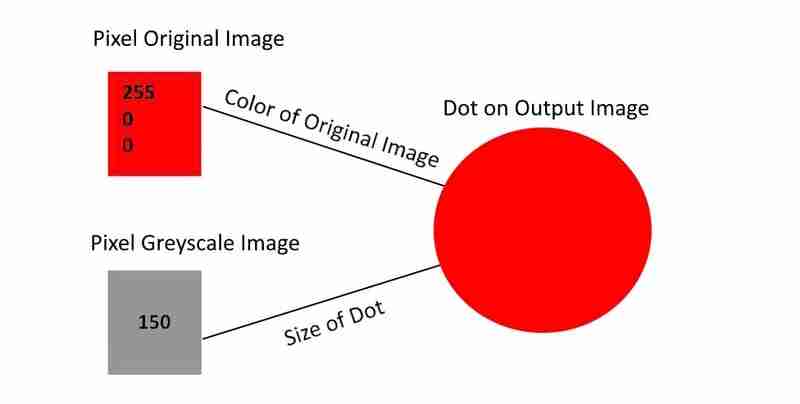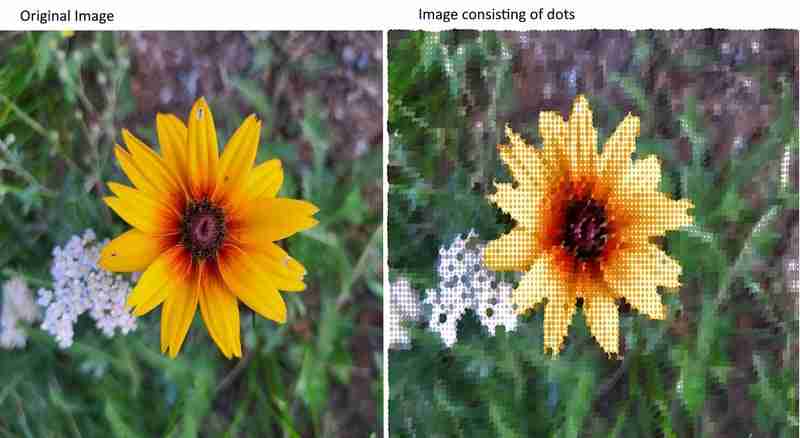简介
开源计算机视觉库 (opencv) 提供免费的编程工具来处理图像或视频文件等视觉输入。它包含许多现成的函数,可以通过不同的编程语言访问。我在这里发布的示例使用 。因此,如果你想理解代码,你至少需要有python和numpy的基础知识。如果您正在寻找 opencv 的介绍,此链接可能非常有价值:[https://dev.to/arpitmandliya/opencv-python-tutorial-3dac]。
像素如何构成图像
在大多数情况下,计算机图像基于 rgb(opencv 中的 bgr)模型。这意味着像素颜色是 red、green 和 blue 组成的混合。还有其他模型(例如,hue、saturation 和 value)和矢量图形(svg 或 pdf),但我不会解释它们他们在这里。
计算机上的图像可以被描述为像素的集合,其中包含颜色信息。用更专业的术语来说,图像是三维阵列(或具有三个颜色通道的像素矩阵),前两个维度确定图像的大小(高度和宽度),第三个维度包含红色、绿色的值和蓝色(每种颜色的值在 0 到 255 之间)。如果一幅图像只有一个颜色通道(8 位图像),则它是具有不同灰度值的灰度图像,范围从 0(黑色)到 255(白色)。 图 1 说明了这一点。

图 1:图像表示为数组。右侧是彩色图像的示例,其中红色、绿色和蓝色的值范围为 0 到 255(0,0,255 为蓝色)。左边是一个灰度图像,其中一个通道代表不同的灰度。
将颜色信息转化为不同大小的点
上述原理可用于使用 numpy 和 opencv 库在 python 中执行图像编辑。在此示例中,我使用循环来处理表示为 numpy 数组的图像。该循环不会迭代图像中的每个像素,而是定期跳过像素(例如,它处理每 10 个像素)。每个处理像素处的灰度值用于确定点的大小(例如,灰度值 100 对应于特定的点大小)。然后使用原始图像的颜色信息将这些点绘制在原始图像的空副本上。总之,我创建了一个图像副本,其中根据原始像素的颜色信息绘制了不同大小的点(参见图 2)。

图 2:为了绘制点,使用原始图像中像素的颜色信息。为了确定点的大小,使用原始图像的灰度版本。
下面您可以找到代码,图 3 显示了可能的结果。
import numpy as np import cv2 # load an image; image has to be in working directory when giving no path information img = cv2.imread('FlowerPower.jpg',cv2.IMREAD_UNCHANGED) # show the dimensions of the image array print(img.shape) # choose a resizing factor for the whole image; to depict it on computer screen resizing = .2 #convert original image to greyscale image img_grey = cv2.cvtColor(img,cv2.COLOR_BGR2GRAY) # make a copy of the orignal image img_output = img.copy() # make a white canvas by assigning the color white (255,255, 255) to each pixel # [:,:] covers all values of the first and second array dimension img_output[:,:] = [255,255,255] # or with black [0,0,0] or any other color # Settings for looping over the image step_width = 40 # steps of loop; here: every 30th pixel # - 1 fills circle that is drawn onto output image; positive value define # line thickness of circle thickness = -1 perc = .2 # size factor for drawing circles/dots onto output image # for loops running over the first two dimensions of the array (width and height) # step_width defines which pixels are included for i in range(2, img.shape[0] - step_width, step_width): for u in range(2, img.shape[1] - step_width, step_width): # radius (dot size) is based on the value of greyscale version of original image # at the current index; e.g., pixel at i = 10, u = 30 might have 123 # perc variable modifies dot size radius = int((255-img_grey[i,u])*perc) +1 if radius <= 0: radius +=1 # take color from pixel at position [i,u] of original image # e.g., i = 10, u = 30 might have [123,0,61] color = img[i,u].astype(int).tolist() # draw a circle on output image using dot size based on greyscale # value with color of original image cv2.circle(img_output, (u,i), radius, color, thickness) # resize images, so they are not too big for computerscreen # based on the resizing variable defined at the top of the page img_size = img.shape img_sm = cv2.resize(img,(int(img_size[1]*resizing), int(img_size[0] * resizing)), interpolation = cv2.INTER_CUBIC) # open window that shows original image cv2.imshow("Original", img_sm) img_output_sm = cv2.resize(img_output,(int(img_size[1]*resizing), int(img_size[0]* resizing)), interpolation = cv2.INTER_CUBIC) # show the dotted image cv2.imshow("Dotted Image", img_output_sm)

图 3:右侧显示原始图像,左侧显示基于此处提供的代码的虚线版本。
我希望我以全面的方式呈现了代码,并且有人可能会发现它有用。如果你愿意的话,可以尝试一下。用矩形替换圆形,选择不同大小的圆形,更改循环步长的值等,看看会发生什么。
以上就是使用 OpenCv 制作简单的点画法的详细内容,更多请关注php中文网其它相关文章!
 微信扫一扫打赏
微信扫一扫打赏
 支付宝扫一扫打赏
支付宝扫一扫打赏

